药学英语试卷新建
药学专业英语试卷
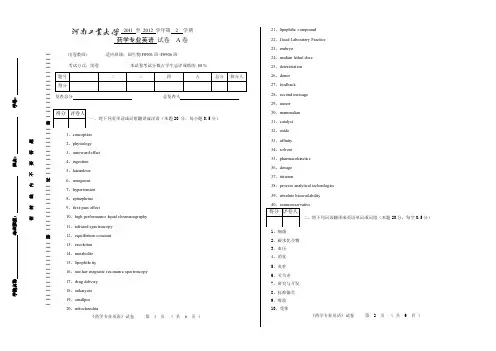
2011 至 2012 学年第 2 学期药学专业英语 试卷 A 卷出卷教师: 适应班级:国生物F0903班~F0906班考试方式:闭卷 本试卷考试分数占学生总评成绩的 80 %复查总分 总复查人一、将下列英单词或词组翻译成汉语(本题20 分,每小题0.5分)1、conception2、physiology3、untoward effect4、ingestion5、hazardous6、antagonist7、hypertension8、epinephrine9、first-pass effect10、high performance liquid chromatography 11、infrared spectroscopy 12、equilibrium constant 13、resolution 14、metabolite 15、lipophilic ity16、nuclear magnetic resonance spectroscopy 17、drug delivery 18、eukaryote 19、smallpox 20、mitochondria《药学专业英语》试卷 第 1 页 ( 共 6 页 )21、lipophilic compound 22、Good Laboratory Practice 23、embryo24、median lethal dose 25、deterioration 26、donor 27、feedback 28、second message 29、tumor30、mammalian 31、catalyst 32、oxide 33、affinity 34、solvent35、pharmacokinetics 36、dosage 37、titration38、process analytical technologies 39、absolute bioavailability二、将下列词语翻译成英语单词或词组(本题20分,每空0.5分)1、细菌2、碳水化合物3、血压4、消化5、炎症6、关节炎7、研究与开发8、标准偏差9、吸收 10、受体《药学专业英语》试卷 第 2 页 ( 共 6 页 )学院名称 专业班级: 姓名: 学号:密 封 线 内 不 要 答 题┃┃┃┃┃┃┃┃┃┃┃┃┃┃┃密 ┃┃┃┃┃┃┃┃┃┃┃封 ┃┃┃┃┃┃┃┃┃┃┃线┃┃┃┃┃┃┃┃┃┃┃┃┃┃┃11、药物化学 12、构效关系 13、保质期 14、药理学 15、免疫学 16、药效学17、排泄物,分泌物excretion/feces 18、水解(作用) 19、生物转化 20、成瘾性 21、阻断药 22、急性反应 23、效应 24、扩散 25、气-固色谱法 26、机制 27、发酵 28、标准溶液 29、中医学 30、临床试验 31、血浆 32、固态 33、研究生课程 34、胶囊 35、染色体 36、酶 37、抑制剂 38、碱基 39、核糖体 40、口服液三、将下列英文文章翻译成汉语(本题30分)Separation TechniquesNearly all the samples presented to the pharmaceutical analyst are mixtures ,sometimes very complex ones. The determination of the amount of each isolated component is usually a simple《药学专业英语》试卷 第 3 页 ( 共 6 页 )matter. The analysis of these same components in each other’s presence may ,however ,be difficult or even impossible because of interference by one substance in the assay of another. Interference can take several forms. The interfering substance can respond quantitatively to the analytical method for the desired component. An example is the interference caused by acetic acid in the assay of hydrochloric acid by titration with alkali. This is not an entirety hopeless situation ,for the analysis will at least yield the sum of the amounts of the desired component and the interfering component. Another common example is the interference observed in absorption spectroscopy when two solutes have overlapping absorption bands. Sometimes the interference is a partial, nonquantitative response to the assay. For example ,the nonaqueous titration of weakly acidic drugs in tablets containing stearic acid may be unsuccessful because of consumption of titrant by the stearie acid; this is not a reproducible effect ,probably because of incomplete dissolution of stearic acid in the titration medium. It is very difficult to compensate for interferences of this type. Another commonly encountered form of interference is an impairment of the analytical method for the desired component ,leading to nonquantitative results even for this component. A trace of copper in a sample of magnesium can vitiate a visual complexometric titration of the magnesium by poisoning the indicator. Another instance is the quenching of quinine fluorescence by hydrochloric acid.When an analytical method cannot be applied directly to a mixture because of possible interference ,a separation of the mixture into its components may be necessary.《药学专业英语》试卷 第 4 页 ( 共 6 页 )学院名称 专业班级: 姓名: 学号:密 封 线 内 不 要 答 题┃┃┃┃┃┃┃┃┃┃┃┃┃┃┃密 ┃┃┃┃┃┃┃┃┃┃┃封┃┃┃┃┃┃┃┃┃┃┃线┃┃┃┃┃┃┃┃┃┃┃┃┃┃┃四、将下面两段文章翻译成英语(本题20分,每题10分)1、制药行业的从业者从事的是药品销售和买卖,以及药品的研究与开发。
专业英语试卷-生物制药.doc
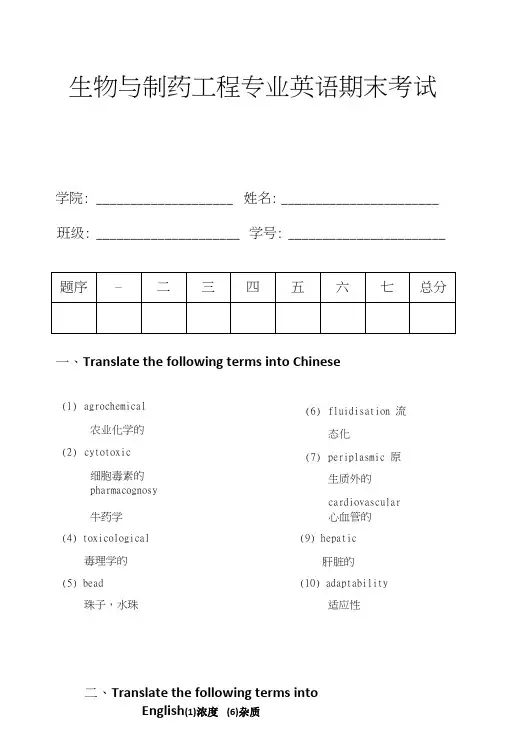
(1) agrochemical 农业化学的(2) cytotoxic 细胞毒素的pharmacognosy(6) fluidisation 流态化 (7) periplasmic 原生质外的cardiovascular牛药学 心血管的(4) toxicological(9) hepatic 毒理学的肝脏的 (5) bead (10) adaptability珠子,水珠 适应性二、Translate the following terms intoEnglish (1)浓度(6)杂质生物与制药工程专业英语期末考试学院: ____________________ 姓名: _______________________ 班级: _____________________ 学号: _______________________ 题序—- 二 三 四 五 六 七 总分一、Translate the following terms into Chineseimpurity(7) 成分与性状discrip tioii(8) 药理作用 phamacological actions(9) 气相色谱 gas chromatography(10) 离子色谱ion chromatographconcentrotion(2) 中性neutrali ty (3) 极易溶解very soluble (4) 定量分析quantitative analysis (5) 等当点equivalent point 三、Word Building (答够十个得满分)antiantibioticantibiotic 抗生素;抗菌的 ant 讦oam 消泡齐U antitussive 止咳药antihistaminic 抗组胺 剂 antineoplastic 抗月中瘤的 antidepressant 抗扌卬郁剂 antianginal 抗心绞痛 antibodv 抗体 an ticoagula nt 抗凝血齐 U an tifoaming^j 沫的 antifun gal 抗真菌 G 勺 anti ・in fectives 抗感染药物antioxidant 抗氧剂 antithrombin 抗凝血酶an tit ode 解毒剂 等(1) Biologists and chemists divide compounds into two principal classes,inorganic and organic.生物学家和化学家将化合物分为两类,无机和有机。
药物英语期末试题及答案
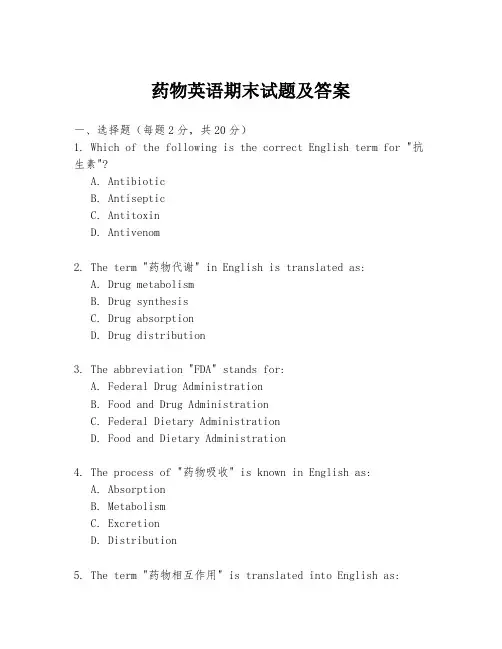
药物英语期末试题及答案一、选择题(每题2分,共20分)1. Which of the following is the correct English term for "抗生素"?A. AntibioticB. AntisepticC. AntitoxinD. Antivenom2. The term "药物代谢" in English is translated as:A. Drug metabolismB. Drug synthesisC. Drug absorptionD. Drug distribution3. The abbreviation "FDA" stands for:A. Federal Drug AdministrationB. Food and Drug AdministrationC. Federal Dietary AdministrationD. Food and Dietary Administration4. The process of "药物吸收" is known in English as:A. AbsorptionB. MetabolismC. ExcretionD. Distribution5. The term "药物相互作用" is translated into English as:A. Drug interactionB. Drug reactionC. Drug combinationD. Drug synergy6. Which of the following is the correct translation for "药物副作用"?A. Drug side effectB. Drug adverse effectC. Drug secondary effectD. Drug negative effect7. The abbreviation "OTC" refers to:A. Over The CounterB. On The CounterC. Out The CounterD. Off The Counter8. The term "药物耐受性" in English is:A. Drug toleranceB. Drug resistanceC. Drug dependenceD. Drug sensitivity9. The process of "药物排泄" is known in English as:A. ExcretionB. EliminationC. SecretionD. Ejection10. The term "药物剂量" is translated into English as:A. Drug dosageB. Drug amountC. Drug quantityD. Drug volume二、填空题(每空2分,共20分)11. The English term for "药物制剂" is __________.Answer: Pharmaceutical formulation12. The abbreviation "NDC" stands for __________.Answer: National Drug Code13. "药物过敏反应" is translated into English as __________. Answer: Drug allergy reaction14. The process of "药物作用机制" is known in English as__________.Answer: Mechanism of drug action15. The term "药物依赖性" is translated into English as__________.Answer: Drug dependence16. The abbreviation "IV" in medical terms refers to__________.Answer: Intravenous17. "药物处方" in English is __________.Answer: Drug prescription18. The process of "药物筛选" is known in English as__________.Answer: Drug screening19. The term "药物不良反应" is translated into English as__________.Answer: Adverse drug reaction20. The abbreviation "BID" stands for __________.Answer: Twice a day三、简答题(每题10分,共20分)21. Explain the difference between "Drug metabolism" and "Drug elimination".Answer: Drug metabolism refers to the process by whichthe body breaks down and modifies a drug into more easily excretable forms. Drug elimination, on the other hand, is the process by which the body removes the drug or its metabolites from the body, typically through the kidneys, liver, or lungs.22. What is the significance of "Drug-drug interactions" in clinical practice?Answer: Drug-drug interactions occur when two or more drugs affect each other's action or effectiveness. These interactions can lead to increased or decreased effectiveness, increased side effects, or even toxicity, which is why theyare significant in clinical practice to ensure patient safety and the effectiveness of treatment.四、论述题(每题15分,共40分)23. Discuss the importance of understanding "Drug resistance" in the context of antimicrobial therapy.Answer: Understanding drug resistance is crucial in antimicrobial therapy as it helps in the appropriate selection of antibiotics to prevent the development of resistant strains. It also guides the development of new antimicrobial agents and informs treatment strategies to combat infections caused by resistant pathogens.24. Elaborate on the role of "Pharmacovigilance" in ensuring patient safety.Answer: Pharmacovigilance is the science and activities relating to the detection, assessment, understanding, and prevention of adverse effects or any other drug-related problem. It plays a vital role in ensuring patient safety by monitoring the safety profile of marketed drugs, identifying risks, and taking appropriate regulatory actions to minimize harm to patients.五、翻译题(每题5分,共20分)25. Translate the following sentence into English: "药物的剂量应根据患者的具体情况来调整。
英文药理学考卷样题

英文药理学考卷样题一、选择题(每题2分,共40分)1. Which of the following is NOT a route of drug administration?A. OralB. IntravenousC. TransdermalD. InhalationE. Intramuscular2. The process which a drug enters the bloodstream is known as:A. AbsorptionB. DistributionC. MetabolismD. ExcretionE. Bioavailability3. Which of the following is a measure of the rate at which a drug leaves the bloodstream?A. HalflifeB. ClearanceC. Volume of distributionD. BioavailabilityE. Therapeutic index4. The drug concentration in the blood that produces a therapeutic effect is known as:A. Minimum effective concentrationB. Maximum effective concentrationC. Toxic concentrationD. Subtherapeutic concentrationE. Steadystate concentration5. Which of the following is a type of adverse drug reaction?A. AllergyB. ToleranceC. DependencyD. WithdrawalE. All of the above6. The study of how drugs interact with the body is known as:A. PharmacodynamicsB. PharmacokineticsC. PharmacognosyD. PharmacoepidemiologyE. Pharmacotherapy7. Which of the following is a phase I drug metabolism reaction?A. OxidationB. ReductionC. HydrolysisD. ConjugationE. All of the above8. Which organ is primarily responsible for drug metabolism?A. LiverB. KidneysC. LungsD. HeartE. Skin9. A drug that increases the activity of an enzyme is known as:A. InducerB. InhibitorC. AgonistD. AntagonistE. Allosteric modulator10. A drug that binds to a receptor and produces an effect is known as:A. AgonistB. AntagonistC. Inverse agonistD. Partial agonistE. Allosteric modulator11. Which of the following is a measure of a drug's potency?A. EC50B. ED50C. LD50D. TD50E. Therapeutic index12. Which of the following is a type of drug interaction?A. Drugdrug interactionB. Drugfood interactionC. Drugdisease interactionD. All of the aboveE. None of the above13. The process which a drug is transported across cell membranes is known as:A. Passive diffusionB. Active transportC. Facilitated diffusionD. OsmosisE. Pinocytosis14. Which of the following is a characteristic of a narrow therapeutic index drug?A. A wide margin of safetyB. A narrow margin of safetyC. High potencyD. Low potencyE. High specificity15. Which of the following is a phase II drug metabolism reaction?A. OxidationB. ReductionC. HydrolysisD. ConjugationE. All of the aboveA. Dry mouthB. ConstipationC. Blurred visionD. All of the aboveE. None of the above17. Which of the following is a centrally acting antihypertensive drug?A. MethyldopaB. ClonidineC. PropranololD. AtenololE. Hydrochlorothiazide18. Which of the following is a firstline treatment for hypertension?A. DiureticsB. BetablockersC. ACE inhibitorsD. Calcium channel blockersE. All of the aboveA. MyopathyB. RhabdomyolysisC. Liver dysfunctionD. All of the aboveE. None of the above20. Which of the following is a penicillinaseresistant penicillin?A. Penicillin GB. AmoxicillinC. AmpicillinD. OxacillinE. Cloxacillin二、填空题(每题2分,共30分)21. The process which a drug binds to a receptor and produces a biological response is known as ____________.22. The three phases of drug action are ____________, ____________, and ____________.23. The drug concentration in the blood that produces a therapeutic effect is known as the ____________ concentration.24. The ____________ is responsible for the conversion ofa drug into a more watersoluble一、选择题答案1. E2. A3. B4. B5. E6. A7. A8. A9. A10. A11. B12. D13. A14. B15. D16. D17. B18. E19. D20. E二、填空题答案21. Pharmacodynamics22. Absorption, Distribution, Metabolism23. Therapeutic24. Liver1. 药物代谢动力学(Pharmacokinetics)药物吸收(Absorption)药物分布(Distribution)药物代谢(Metabolism)药物排泄(Excretion)药物浓度时间曲线(Concentrationtime curve)半衰期(Halflife)清除率(Clearance)分布容积(Volume of distribution)2. 药物效应动力学(Pharmacodynamics)药物作用机制(Mechanism of action)受体理论(Receptor theory)效应强度(Potency)治疗指数(Therapeutic index)药物副作用(Side effects)药物相互作用(Drug interactions)3. 药物分类与作用抗高血压药(Antihypertensives)抗菌药物(Antibiotics)抗胆碱能药物(Anticholinergic drugs)他汀类药物(Statins)各题型知识点详解及示例:选择题:考察学生对药物基本概念的理解,如药物代谢动力学和药物效应动力学的区别(题6、7、8)。
药剂英文试题及答案高中
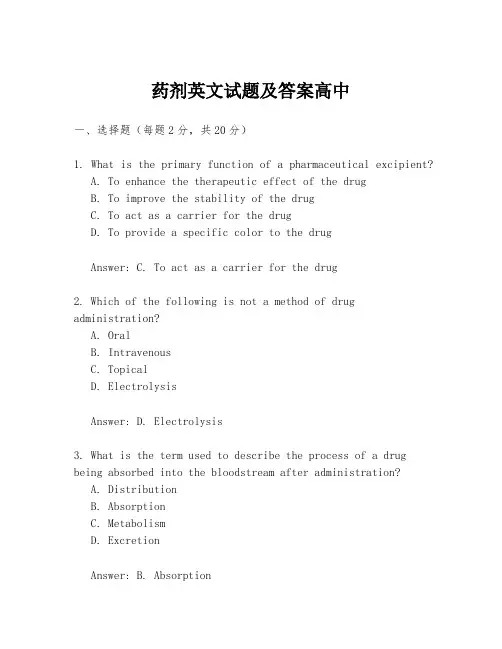
药剂英文试题及答案高中一、选择题(每题2分,共20分)1. What is the primary function of a pharmaceutical excipient?A. To enhance the therapeutic effect of the drugB. To improve the stability of the drugC. To act as a carrier for the drugD. To provide a specific color to the drugAnswer: C. To act as a carrier for the drug2. Which of the following is not a method of drug administration?A. OralB. IntravenousC. TopicalD. ElectrolysisAnswer: D. Electrolysis3. What is the term used to describe the process of a drug being absorbed into the bloodstream after administration?A. DistributionB. AbsorptionC. MetabolismD. ExcretionAnswer: B. Absorption4. Which of the following is a bioequivalence study?A. Study of drug interactionsB. Study of drug absorptionC. Comparison of the rate and extent to which the active ingredient becomes available after two different administration formsD. Study of drug stabilityAnswer: C. Comparison of the rate and extent to which the active ingredient becomes available after two different administration forms5. What is the main purpose of a controlled-release drug formulation?A. To reduce the frequency of administrationB. To increase the drug's solubilityC. To enhance the drug's tasteD. To decrease the drug's side effectsAnswer: A. To reduce the frequency of administration二、填空题(每题2分,共20分)6. The ________ of a drug refers to its ability to reach the systemic circulation after administration.Answer: Bioavailability7. A ________ is a type of drug delivery system that allows for the controlled release of a drug.Answer: Transdermal patch8. The ________ is the study of the physical and chemical properties of drugs.Answer: Pharmaceutical chemistry9. In pharmaceuticals, ________ is the process of turning a liquid into a fine spray.Answer: Nebulization10. The ________ is a technique used to determine the purity and composition of a substance.Answer: Chromatography三、简答题(每题10分,共40分)11. Explain the importance of drug stability in pharmaceutical formulations.Answer: Drug stability is crucial in pharmaceutical formulations as it ensures that the drug maintains its potency, purity, and safety over time. Unstable drugs can degrade, leading to reduced efficacy or the formation of harmful by-products.12. Describe the role of a pharmacist in the healthcare system.Answer: A pharmacist plays a pivotal role in the healthcare system by preparing and dispensing medications, providing drug information, monitoring patient medication therapy for safety and efficacy, and offering advice on thesafe use of medications.13. What are the factors that influence the bioavailability of a drug?Answer: Factors influencing drug bioavailability include the drug's chemical properties, the formulation, the route of administration, the presence of food, and the patient's physiological state.14. Discuss the concept of drug-drug interactions and their clinical significance.Answer: Drug-drug interactions occur when two or more drugs affect each other's action or efficacy. These interactions can lead to increased side effects, reduced therapeutic effect, or even toxicity, which is why understanding and managing them is of clinical significance.四、论述题(共20分)15. Discuss the ethical considerations in the development and use of new pharmaceuticals.Answer: Ethical considerations in the development and use of new pharmaceuticals include ensuring patient safety, maintaining transparency in clinical trials, avoiding conflicts of interest, respecting patient autonomy, and ensuring equitable access to medications, especially for vulnerable populations.结束语:通过这份药剂英文试题及答案,我们希望能够帮助高中学生更好地掌握药剂学的基础知识,并培养他们对药物研发和应用的深入理解。
药学通识英语试题及答案
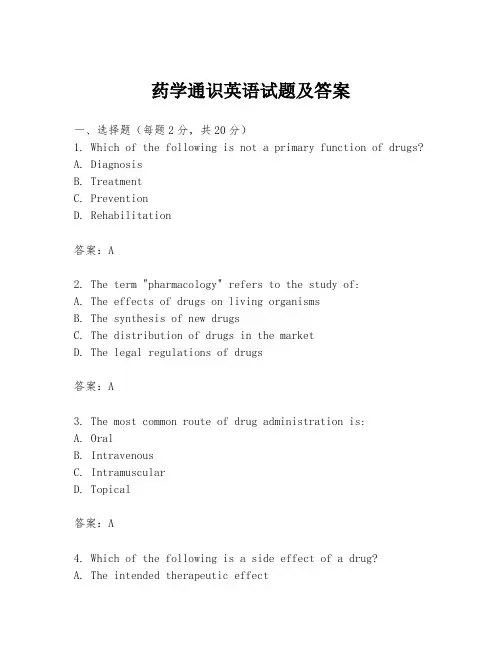
药学通识英语试题及答案一、选择题(每题2分,共20分)1. Which of the following is not a primary function of drugs?A. DiagnosisB. TreatmentC. PreventionD. Rehabilitation答案:A2. The term "pharmacology" refers to the study of:A. The effects of drugs on living organismsB. The synthesis of new drugsC. The distribution of drugs in the marketD. The legal regulations of drugs答案:A3. The most common route of drug administration is:A. OralB. IntravenousC. IntramuscularD. Topical答案:A4. Which of the following is a side effect of a drug?A. The intended therapeutic effectB. An effect that is harmful and unintendedC. The effect of the drug on a different organD. The effect of the drug on a different disease答案:B5. The half-life of a drug refers to:A. The time it takes for the drug to be completely eliminated from the bodyB. The time it takes for the drug's concentration to decrease by halfC. The time it takes for the drug to reach its maximum concentrationD. The time it takes for the drug to be absorbed into the bloodstream答案:B6. The bioavailability of a drug is:A. The percentage of the drug that is absorbed into the bloodstreamB. The percentage of the drug that is excreted unchangedC. The percentage of the drug that is metabolized by theliverD. The percentage of the drug that is stored in the fat tissues答案:A7. The therapeutic index of a drug is an indicator of:A. The drug's effectivenessB. The drug's safetyC. The drug's cost-effectivenessD. The drug's duration of action答案:B8. A drug's pharmacokinetics involves the study of:A. How the body affects the drugB. How the drug affects the bodyC. How the drug is synthesizedD. How the drug is regulated by the government答案:A9. The first-pass metabolism refers to:A. The metabolism of a drug after it is absorbed into the bloodstreamB. The metabolism of a drug before it enters the bloodstreamC. The metabolism of a drug after it is excreted from the bodyD. The metabolism of a drug after it is distributed to the tissues答案:B10. The term "drug interaction" refers to:A. The combined effect of two or more drugsB. The effect of one drug on the action of another drugC. The effect of a drug on the patient's behaviorD. The effect of a drug on the patient's diet答案:B二、填空题(每题2分,共20分)1. The study of the effects of drugs on living organisms is called __________.答案:pharmacology2. The intended therapeutic effect of a drug is known as its __________.答案:pharmacological effect3. The process by which a drug is absorbed into the bloodstream is called __________.答案:absorption4. A drug that is taken orally and then undergoes metabolism in the liver before entering the bloodstream is subject to__________.答案:first-pass metabolism5. The time it takes for the drug's concentration to decrease by half is known as the drug's __________.答案:half-life6. The percentage of the drug that is absorbed into the bloodstream is referred to as the drug's __________.答案:bioavailability7. The study of how the body affects the drug is known as the pharmacokinetics of the drug, while the study of how the drug affects the body is known as the __________.答案:pharmacodynamics8. A drug's safety is indicated by its __________.答案:therapeutic index9. The combined effect of two or more drugs is known as a__________.答案:drug interaction10. The unintended harmful effect of a drug is called a(n)__________.答案:side effect三、简答题(每题10分,共40分)1. Explain the difference between the pharmacokinetics and pharmacodynamics of a drug.答案:Pharmacokinetics is the study of how the body affects the drug, including absorption, distribution, metabolism, and excretion. Pharmacodynamics, on the other hand, is the study of how the drug affects the body, including the drug's mechanism of action and its effects on physiological functions.2. Describe the significance of a drug's half-life inclinical practice.答案:The half-life of a drug is significant in clinical practice as it determines the frequency of drug administration. A shorter half-life may require more frequent dosing, while a longer half-life allows for less frequent dosing. It also。
药物分析英语试题及答案
药物分析英语试题及答案一、选择题(每题2分,共20分)1. Which of the following is not a method for drug analysis?A. ChromatographyB. SpectrophotometryC. SpectroscopyD. Thermometry2. The International Conference on Harmonization (ICH) is related to which field?A. Environmental protectionB. Drug regulationC. International tradeD. Space exploration3. What is the purpose of a calibration curve in drug analysis?A. To determine the purity of a drugB. To establish a relationship between concentration and responseC. To calculate the dosage of a drugD. To identify unknown compounds4. The term "bioequivalence" refers to the comparison of:A. The chemical structures of two drugsB. The manufacturing processes of two drugsC. The rate and extent of absorption of two drugsD. The side effects of two drugs5. The process of "assay" in drug analysis is to:A. Determine the quantity of a specific component in a sampleB. Identify the presence of impurities in a sampleC. Measure the temperature of a sampleD. Calculate the pH of a sample6. Which of the following is a common solvent used in drug analysis?A. WaterB. EthanolC. Both A and BD. Neither A nor B7. The term "stability testing" in drug analysis is to evaluate:A. The color change of a drug over timeB. The chemical stability of a drug under various conditionsC. The taste of a drugD. The packaging material of a drug8. What is the role of a placebo in clinical trials?A. To serve as a control groupB. To test the efficacy of a new drugC. To treat the diseaseD. To increase the dosage of a drug9. The process of "extraction" in drug analysis is used to:A. Separate a drug from its impuritiesB. Combine different drugsC. Measure the weight of a drugD. Determine the molecular weight of a drug10. The term "detection limit" in analytical chemistry refers to:A. The smallest amount of a substance that can be detectedB. The largest amount of a substance that can be detectedC. The amount of a substance that is toxicD. The amount of a substance that is required for an assay二、填空题(每题1分,共10分)11. The abbreviation for High-Performance Liquid Chromatography is ______.12. The ______ is a technique used to determine the molecular weight of a compound.13. In drug analysis, the ______ is used to measure the amount of a drug in a biological sample.14. The ______ is a regulatory agency responsible for protecting public health by ensuring the safety, efficacy, and security of human and veterinary drugs.15. The ______ is a method used to determine the purity of a drug by comparing it with a pure standard.三、简答题(每题5分,共20分)16. Explain the difference between qualitative and quantitative analysis in drug analysis.17. Describe the steps involved in the development of a new drug from discovery to market.18. What are the key factors considered in the design of a stability testing program for a pharmaceutical product?19. Discuss the importance of bioequivalence studies in the approval of generic drugs.四、论述题(每题15分,共30分)20. Discuss the role of analytical chemistry in the development and quality control of pharmaceuticals.21. Critically evaluate the use of biomarkers in drug metabolism and pharmacokinetics studies.五、案例分析题(共20分)22. A pharmaceutical company is developing a new drug for the treatment of hypertension. The company has conducted a series of tests to determine the drug's efficacy, safety, and stability. Based on the results, the company has decided to proceed with clinical trials. Discuss the types of tests that may have been conducted and the significance of each test in the drug development process.参考答案:一、选择题1-5: DBBCA6-10: CBCAB二、填空题11. HPLC12. Mass spectrometry13. Bioassay14. FDA (Food and Drug Administration)15. Thin-layer chromatography三、简答题16. Qualitative analysis identifies the presence or absenceof specific components in a sample, whereas quantitative analysis measures the exact amount of a component.17. The steps include target identification, lead optimization, preclinical testing, clinical trials (phases I-III), regulatory review, and post-marketing surveillance. 18. Factors include temperature, humidity, light exposure, and the duration of the test to ensure the drug's stability under various conditions.19. Bioequivalence studies ensure that generic drugs have the。
药学英语 标准试卷6
一、翻译(共20分,每题1分)。
1 戊烷2 腺苷酸3 氯4 碘5 脯氨酸6 色氨酸7 酮8 酰胺9 CaCO310 氯化钠11 Cyclohexane 12 Decane13 Butanol 14 Sodium15 Tyrosine 16 Ethyl acetate17 Mercury 18 Phenol19 Potassium carbonate 20 Cysteine答案: 1 Pentane 2 Adenylic acid 3 Chlorine 4 Iodine5 Proline6 Tryptophan7 Acetone 8 Amide9 Ccalcium carbonate 10 Sodium chloride11 环己烷12 癸烷13 丁醇14 钠15 酪氨酸16 乙酸乙酯17 汞18 酚19 碳酸钾20 半胱氨酸二、写出下列缩写的英文全称并翻译(共10分,每题2分)。
1 DMSO:2 TCM:3 GMP:4 HPLC:5 UV/visible: 答案: 1 dimethyl sulfoxide 二甲基亚砜2 Traditional Chinese Medicine 中医3 Good Manufacturing Practice 药品生产和质量管理规范试卷(A)共(5)页第(1 )页4 High Performance (Pressure) Liquid Chromatography 高效液相色谱5 Ultraviolet-visible spectroscopy 紫外分光光度法三、判断,并用×√表示(共16分,每题2分)。
1 ()Analytical chemists also make important contributions to fields as diverse as forensics, archaeology, and space science.2()A selective reaction or test is one that occur only with the substance of interest.3 ()Lead compounds can be obtained from a variety of different sources such as the flora and fauna of the natural world, or synthetic compounds made in the laboratory. There is also the potential of designing lead compounds using computer modeling or NMR spectroscopic studies.4 ()Biomolecules are compounds of nitrogen.5 ()By conyention, pharmacokinetics is defined as the study of the time-course of drug absorption, distribution, metabolism and excretion, whereas the term pharmacodynamics refers to the corresponding pharmacological response.6 ()The degree of aqueous solubility of the drug affects directly the bioavailability of the drug.7 ()Direct comparison with authentic (if available) should be carried out as final confirmation.8 ()Drag design aims to remove the desirable effects of the lead compound and to improve the undesirable effects.答案: 1 √ 2 × 3 √ 4 × 5 √ 6 ?7 √8 ×四、单选题(共14分,每题2分)。
医学英语高考试卷及答案
Section 1: Listening Comprehension (30 points)Part A: Short Conversations (10 points)1. A. The doctor suggests taking a rest.2. B. The woman is scheduled for an operation.3. C. The man needs to change his medication.4. D. The woman is planning a vacation.5. A. The man's blood pressure is normal.6. B. The woman is feeling better.7. C. The doctor is running late.8. D. The patient is allergic to certain drugs.9. A. The patient needs to follow a special diet.10. B. The man is experiencing joint pain.Part B: Long Conversations (10 points)11. What is the main topic of the conversation?- Answer: The conversation is about the importance of regular check-ups for maintaining health.12. Why does the woman suggest visiting the doctor regularly?- Answer: The woman suggests visiting the doctor regularly because it helps in early detection and treatment of health issues.13. What are the three main reasons mentioned for regular health check-ups?- Answer: The three main reasons mentioned are early detection of diseases, prevention of health complications, and maintaining overall well-being.Part C: Passages (10 points)14. What is the main purpose of the passage?- Answer: The main purpose of the passage is to inform about the benefits of vaccines and the importance of vaccination.15. According to the passage, what are the two types of vaccines mentioned?- Answer: The two types of vaccines mentioned are live attenuated vaccines and inactivated vaccines.16. Why are some people advised not to receive certain vaccines?- Answer: Some people are advised not to receive certain vaccines due to their weakened immune systems or allergic reactions.Section 2: Reading Comprehension (40 points)Passage 1: 10 pointsRead the passage and answer the questions that follow.The role of nutrition in maintaining good healthGood nutrition is essential for maintaining good health and preventing diseases. A balanced diet provides the body with the necessary nutrients to function properly. Here are some key nutrients and their functions:1. Proteins: Essential for the growth and repair of tissues.2. Carbohydrates: The body's main source of energy.3. Fats: Important for insulation and the absorption of fat-soluble vitamins.4. Vitamins: Needed in small amounts for various bodily functions.5. Minerals: Important for bone health, muscle function, and nerve transmission.It is important to consume a variety of foods to ensure a balanced intake of these nutrients. Foods rich in vitamins and minerals include fruits, vegetables, whole grains, lean proteins, and dairy products.Questions:1. What is the main idea of the passage?- Answer: The main idea of the passage is the importance of good nutrition in maintaining health.2. According to the passage, what are the five key nutrients mentioned?- Answer: The five key nutrients mentioned are proteins, carbohydrates, fats, vitamins, and minerals.3. Why is it important to consume a variety of foods?- Answer: It is important to consume a variety of foods to ensure a balanced intake of all necessary nutrients.Passage 2: 10 pointsRead the passage and answer the questions that follow.The importance of physical activityRegular physical activity is crucial for maintaining good health and preventing chronic diseases. Exercise has numerous benefits, including:1. Cardiovascular health: Regular exercise strengthens the heart and improves blood circulation.2. Weight management: Physical activity helps in burning calories and maintaining a healthy weight.3. Mental health: Exercise can reduce stress, anxiety, and depression.4. Bone and muscle health: Weight-bearing exercises strengthen bones and muscles.5. Longevity: Regular exercise has been linked to a longer life expectancy.It is recommended that adults engage in at least 150 minutes of moderate-intensity aerobic exercise or 75 minutes of vigorous-intensityaerobic exercise per week, along with muscle-strengthening activities on two or more days a week.Questions:1. What is the main topic of the passage?- Answer: The main topic of the passage is the importance ofphysical activity in maintaining health.2. According to the passage, what are the five benefits of regular exercise?- Answer: The five benefits of regular exercise mentioned are cardiovascular health, weight management, mental health, bone and muscle health, and longevity.3. How much physical activity is recommended for adults?- Answer: Adults are recommended to engage in at least 150 minutesof moderate-intensity aerobic exercise or 75 minutes of vigorous-intensity aerobic exercise per week, along with muscle-strengthening activities on two or more days a week.Section 3: Writing (20 points)Write a short essay (100-120 words) on the following topic:How has the COVID-19 pandemic affected healthcare systems worldwide?Answer:The COVID-19 pandemic has had a profound impact on healthcare systems worldwide. Firstly, it has led to increased demand for medical resources, including hospital beds, ventilators, and personal protective equipment. Secondly, healthcare workers have faced unprecedented challenges, including high levels of stress and burnout. Additionally, routine medical services have been disrupted, leading to delayed diagnoses and treatments for other conditions. Despite these challenges, the pandemic has also highlighted the importance of global collaboration and the need for robust healthcare infrastructure.。
专业英语试卷-生物制药
生物与制药工程专业英语期末考试学院: 姓名:____________________班级: 学号:一、Translate the following terms into Chinese(1)agrochemical (6)fluidisation 农业化学的流态化(2)cytotoxic (7)periplasmic细胞毒素的原生质外的(3)pharmacognosy (8)cardiovascular生药学心血管的(4)toxicological (9)hepatic毒理学的肝脏的(5)bead (10)adaptability珠子,水珠适应性二、Translate the following terms into English(1)浓度(6)杂质concentration impurity(2)中性(7)成分与性状neutrality discription(3)极易溶解(8)药理作用very soluble phamacological actions(4)定量分析(9)气相色谱quantitative analysis gas chromatography(5)等当点(10)离子色谱equivalent point ion chromatograph三、Word Building(答够十个得满分)anti-antibiotic antibiotic抗生素;抗菌的antifoam 消泡剂antitussive止咳药antihistaminic抗组胺剂antineoplastic抗肿瘤的antidepressant抗抑郁剂antianginal抗心绞痛antibody抗体anticoagulant抗凝血剂antifoaming防沫的antifungal抗真菌的anti-infectives抗感染药物antioxidant抗氧剂antithrombin抗凝血酶antitode 解毒剂等四、Translate the following sentences into Chinese(1)Biologists and chemists divide compounds into two principal classes, inorganic and organic.生物学家和化学家将化合物分为两类,无机和有机。
